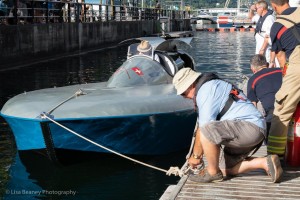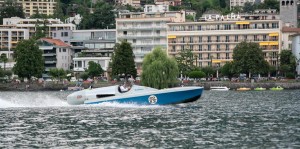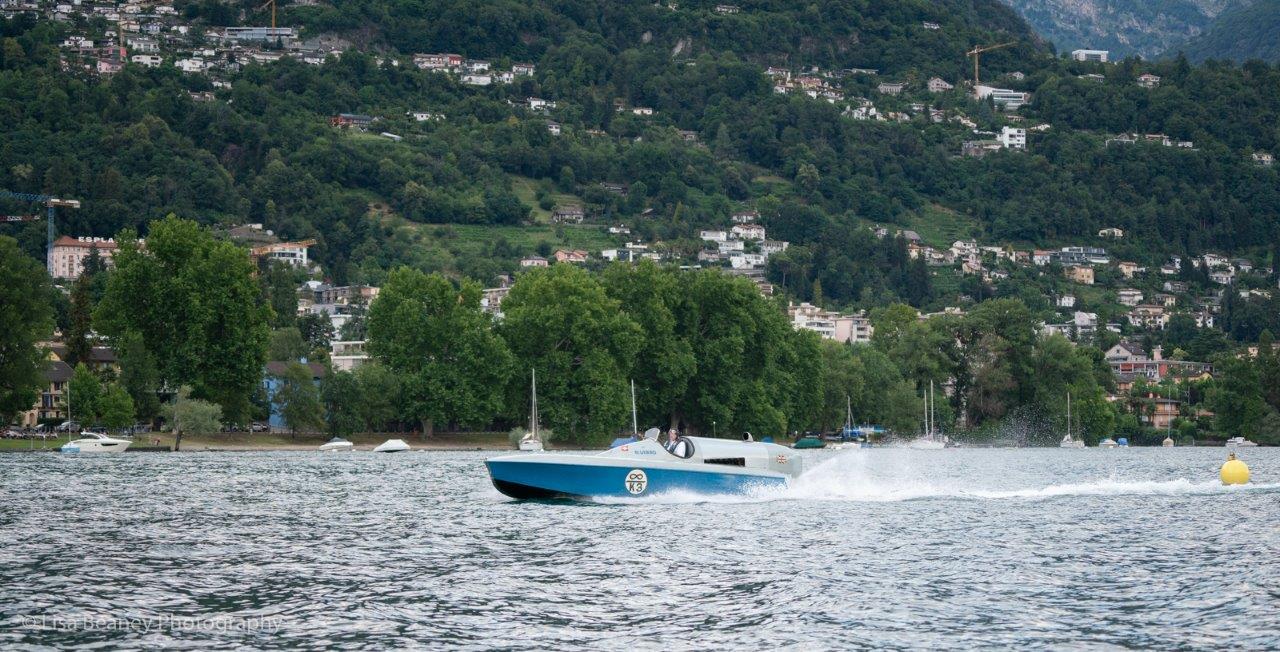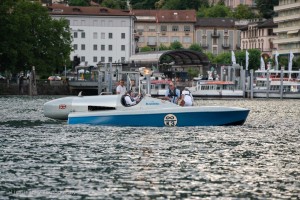(for the 80th Anniversary of her World Water Speed Record)
From: David Knight, Secretary, Classic Motor Boat Association; Photos Lisa Beaney
After the partial rebuild of the Rolls Royce engine in 2016/17, the two-day test on Bewl Water in September 2017 was a great success. It had taken almost 18 months to get the magnetos stripped and rebuilt and Karl Foulkes-Halbard and Andy Taylor, his engineer used the time to repair a cracked casing and to strip and overhaul the carburettors. The result was that the engine had never run better; it was noticeably quieter (some of us thought that was a shame), smoother and it started more readily. Sitting around a table that evening reviewing the data, Karl wondered about the chances of getting ‘Bluebird’ K3 back to Lake Maggiore in Switzerland for the 80th Anniversary of her World Water Speed record. Malcolm Campbell had made two of several attempts at the record in Switzerland; one in 1937 and another in 1938. The location was Locarno where his mechanic, Leo Villa had grown up and a place he knew intimately with calm waters sheltered by the mountains. It had long been Karl’s ambition to get her back to Switzerland and now that years of slow restoration were virtually complete, the possibility was tantalisingly close. 
I am one of a team of five from the Classic Motor Boat Association that had been helping Karl in recent years to get K3 running and back on the water. I offered to sound out my contacts within the European Wooden Boat Club and the Riva Historic Society to see if there were any members in Switzerland that might be able to help.
 Communication with the Swiss Authorities was a challenge from the outset but, after five long months, a meeting was convened and to our relief, everyone that needed to be there was there. The town authorities wanted to invite Karl and ‘Bluebird’ K3 to be part of their annual ‘Luci e Ombre’ Festival which is a 3-day event at the beginning of July culminating in a huge firework finale. ‘Luci e Ombre’ translates as ‘Lights and Shadows’ but in essence, it is a huge street party beside the lake with stalls, entertainers, live music, food and drink.
Communication with the Swiss Authorities was a challenge from the outset but, after five long months, a meeting was convened and to our relief, everyone that needed to be there was there. The town authorities wanted to invite Karl and ‘Bluebird’ K3 to be part of their annual ‘Luci e Ombre’ Festival which is a 3-day event at the beginning of July culminating in a huge firework finale. ‘Luci e Ombre’ translates as ‘Lights and Shadows’ but in essence, it is a huge street party beside the lake with stalls, entertainers, live music, food and drink.
During the five months of endless e-mails chasing progress and decisions, I had received offers of help from Bruno Huber, Diego Bianchini and Luca Pagnamenta through the Riva Historic Society. These gentlemen raced classic inboard hydroplanes on Lake Luganno some 30 kilometres away; they were very familiar with Swiss ‘red-tape’ and Bruno made time to attend the meeting. He acted as both interpreter for us and liaison as he was known to the Port Authorities and was respected for his knowledge and experience. Bruno generously offered the use of two of their boats as support boats as they were only a few kilometres away, which would save us the transportation costs. It was an offer we gratefully accepted but the arrangements were to change again some weeks later.
 The next few months were to prove as frustrating as the first five months with a last minute dash for me from Lake Garda to a meeting in Locarno two weeks before ‘Bluebird’ was scheduled to leave. It was at this meeting we discovered that the local authority would supply the two support boats – it made sense because they had many boats already on the lake but finding out which boat and whether or not, we would be allowed to drive them was another unanswered question. In the intervening period I had sent our Swiss hosts the ‘minutes’ of both the meeting as I had understood them, an ‘Event Plan’ and a ‘Risk Assessment in both English and Italian a plan of the proposed 1 kilometre course and the proposed exclusion zone because there was absolutely nothing in writing from them. Eventually hotel rooms were booked, transport arranged and on Monday 3rd July ‘Bluebird’ K3 left the UK en-route to Switzerland. Karl and his crew had arranged to fly out two days later and I decided to drive and shadow the ‘Bluebird’ in case of any problems crossing the border. ‘Bluebird’s’ passage through Switzerland was not without incident but we eventually arrived in Locarno two hours later than planned.
The next few months were to prove as frustrating as the first five months with a last minute dash for me from Lake Garda to a meeting in Locarno two weeks before ‘Bluebird’ was scheduled to leave. It was at this meeting we discovered that the local authority would supply the two support boats – it made sense because they had many boats already on the lake but finding out which boat and whether or not, we would be allowed to drive them was another unanswered question. In the intervening period I had sent our Swiss hosts the ‘minutes’ of both the meeting as I had understood them, an ‘Event Plan’ and a ‘Risk Assessment in both English and Italian a plan of the proposed 1 kilometre course and the proposed exclusion zone because there was absolutely nothing in writing from them. Eventually hotel rooms were booked, transport arranged and on Monday 3rd July ‘Bluebird’ K3 left the UK en-route to Switzerland. Karl and his crew had arranged to fly out two days later and I decided to drive and shadow the ‘Bluebird’ in case of any problems crossing the border. ‘Bluebird’s’ passage through Switzerland was not without incident but we eventually arrived in Locarno two hours later than planned.
Known for snow-capped mountains, even in summer, we were not prepared for the 32°C as we rolled into Locarno; it was hot, we were hot, and tired and there was no sign of the escort we had requested to lead us through to the parking area. I lead the low-loader through the town towards the lake and turned right onto the lake-side road we had been shown in April only to find the road barriered off and a huge marquee erected across the entire width of the road. We had had months of planning and this was not supposed to happen. It was chaotic but we did eventually get ‘Bluebird’ safely parked overnight and then on to the display area on Thursday morning to prepare her for the opening ceremony that same evening.
It was quite a ceremony with tables of food and drink, the Swiss media present and a very generous speech from the Mayor welcoming Karl, ‘Bluebird’ and the team.
The plan, such as it was, gave ‘Bluebird’ on static display for the three days of the festival and on Friday evening she would be moved onto the water and have centre stage for a one-hour display. There was a huge interest in the return of Bluebird to Locarno from just about every quarter but what we didn’t expect was the personal stories that emerged from locals that had family connections. Two elderly gentlemen introduced themselves to us one evening and explained that one of them was just 10 years old when Malcolm Campbell brought Bluebird to Locarno in 1938 and he remembered the occasion. On another occasion a well-dressed family also approached us carrying a family photo album; the husband explained that his father was a local dentist in 1938 and he had photographed both visits of Bluebird. He then showed us the photos in the family album and every single one was signed by Malcolm Campell. Another local ‘character’ arrived clutching a small scruffy cardboard box; inside were approximately 20 small folders each containing a dozen or so black and white negatives of Bluebird and Malcolm Campbell from 1938. As far as we could tell they had never been seen or published before. And there were many more similar stories making it very clear that Malcolm Campbell and Bluebird were still important and carried the affection of many locals 80 years on.
‘Bluebird’ had been allocated a one hour slot from 8.00pm until 9.00pm on Friday evening and she was scheduled to be moved to the slipway at approximately 17.30hrs. Extracting Bluebird and her cradle from the display area and towing her some 400 metres to the slipway was no mean fete but an hour later she slipped into the waters of Lake Maggiore for the first time in 80 years. There were around 200 people overlooking the slipway and along the promenade and there was a spontaneous applause from those watching; it was the culmination of seven months of planning and that single moment caught a number of the team members by surprise with the emotion of it. What followed though was almost farcical. Once in the water and teased off her cradle ‘Bluebird’ was moored against a pontoon for an engine test. At that point the Swiss authorities went into action and ‘Bluebird’ was surrounded by local fire brigade officers, each with a fire extinguisher. Divers arrived and launched their two inflatables, Paramedics arrived with two rigid utility boats and enough equipment for a civil disaster and three Police ribs circled at the end of the channel. Slightly bemused, Karl and engineer Roy went through all their normal checks and ‘Bluebird’s’ 27 litre, V12, Rolls Royce engine burst into life with another round of applause from on-lookers. A Police ‘Sun Top’ rib appeared and took Karl and some of the support boat crew out to inspect the course and give Karl the chance to see where he would be running and get some visual fixes. I have to give the Swiss authorities their credit here because they had set a very credible 1kilometre course, 50 metres wide and marked by sensible buoys. This was surrounded by another a 50 metre exclusion zone patrolled on the periphery by six Police launches and two Security launches. The fear was that private boats would crowd around and possibly impede the proceedings or create wash but in reality most spectators were on the shores of the lake and only three or four private boats ventured onto the water. 
At 19.45hrs we eventually discovered which support boats we were using when they arrive to escort ‘Bluebird’ out to the course. One was the 6 metre Police ‘Sun Top’ rib with a 130HP outboard and the other was a 7 metre Sports Cuddy with a 260HP Mercuiser, owned by a local boatyard and crewed by a father and son. Fortunately, they both spoke a little English. We quickly decided the rib would act as the primary support boat and the Sports Cuddy as the back-up with the film crew in it. With tow-line attached, ‘Bluebird’ was towed slowly out into Lake Maggiore and the course escorted by a Police launch and one of the Security boats.
The co-ordination between the boats was with VHF radios on two frequencies; one for the Swiss authorities and one for the support crew; the lead security boat also had one of the CMBA support crew to act as liaison. Once on the course all the support boats took up their respective positions; the Police rib nudged ‘Bluebird’ into position and we all held our breath. I was in the second support boat with the film crew stationed about a third of the way down the course and I could hear Karl trying to start the engine. We all waited listening to the engine turn, cough and splutter. It was probably only seconds but it felt like an eternity – years of painstaking reconstruction and months of planning just for this moment. The propulsion is direct drive with only a dog-clutch in the cockpit to allow the engine to fire up and run without the boat moving. Eventually the Rolls Royce ‘Meteor’ engine woke up and fired consistently for about a minute before Karl shut it down and engaged the dog-clutch. Another press of the starter and ‘Bluebird’ was off down the course; hesitantly at first but then with a confident roar she shot passed our position. The roar of the engine could be heard reverberating around the mountains surrounding the lake. At the end of the run Karl shut the engine down and coasted to a stop where the support boat took her in tow and turned her round while the engineer check the vital statistics. The team had already agreed that if on the third check everything was still OK then we would dispense with further checks, unless Karl flagged up a problem, and simply turn Bluebird round and line her up to run again. As expected the oil pressure and temperature for the engine and V drive were absolutely fine for the first three runs. During the next hour Karl managed to get 10 runs along the course much to everyone’s delight and he achieved a speed of 52MPH (84KPH) according to the onboard GPS. The city officials were so please that they requested the display to over run but by 9.00pm the wind was getting up and Karl was already struggling with the choppy conditions. By the end of the 10th run Karl reluctantly called a halt to the proceedings and ‘Bluebird’ was towed the long way back around the edge of the lake to more applause. By 11.00pm ‘Bluebird’ was back on display and there was much back-slapping and handshakes of congratulations to Karl and the team for pulling off such an historic anniversary. 
Despite the frustrations, we all have to extend our thanks to the Locarno City Hall authorities for being such generous hosts and the locals that made us all feel so welcome. It was quite an emotional experience.
Two weeks later, Karl and ‘Bluebird’ K3 were the guests of the Thames Traditional Boat Festival where she was allowed to run at ‘tick-over speed’ along the hallowed Henley Rowing Course aided and abetted by two Enviroment Agency launches and the blessing of the Thames (non-tidal) Harbour Master.
Technical data:
1937/1938 Single Step Hydroplane
| Designer: | Fred Cooper M.Inst.N.A. |
| Consultant Engineer: | Reid Railton |
| Builders: | Saunders Roe Ltd. (I.O.W) |
Dimensions and Technical Specifications
| Length overall: | 23′ 0″ (7.01 m) |
| Length at waterline | 22′ 3″ (6.78 m) |
| Width | 9′ 6″ (2.89 m) |
| Draught: | 1′ 9″ (0.53 m) |
| Displacement: | 4,945 lbs. (2243 kg.) |
| Propeller diameter: | 12″ (30.5 cm) to 14″ (35.6 cm) |
| Propeller pitch: | 20″ (50.8 cm) to 27″ (68.6 cm) |
| Propeller speed | 9,500 rpm. |
| Gear ratio: | 3:1 increase on engine revs. |
| Engine: | Rolls Royce R Type Vee 12 |
| Starter | Compressed air type |
Construction
| Main Structure: | Two Rock Elm and Alloy runners |
| Frame: | One piece 7 ply timber |
| Bottom: | 5 ply timber |
| Deck: | 6 ply timber |
| Top deck: | Aircraft canvas and dope |
| Fittings: | Alcan and Duralmin |



